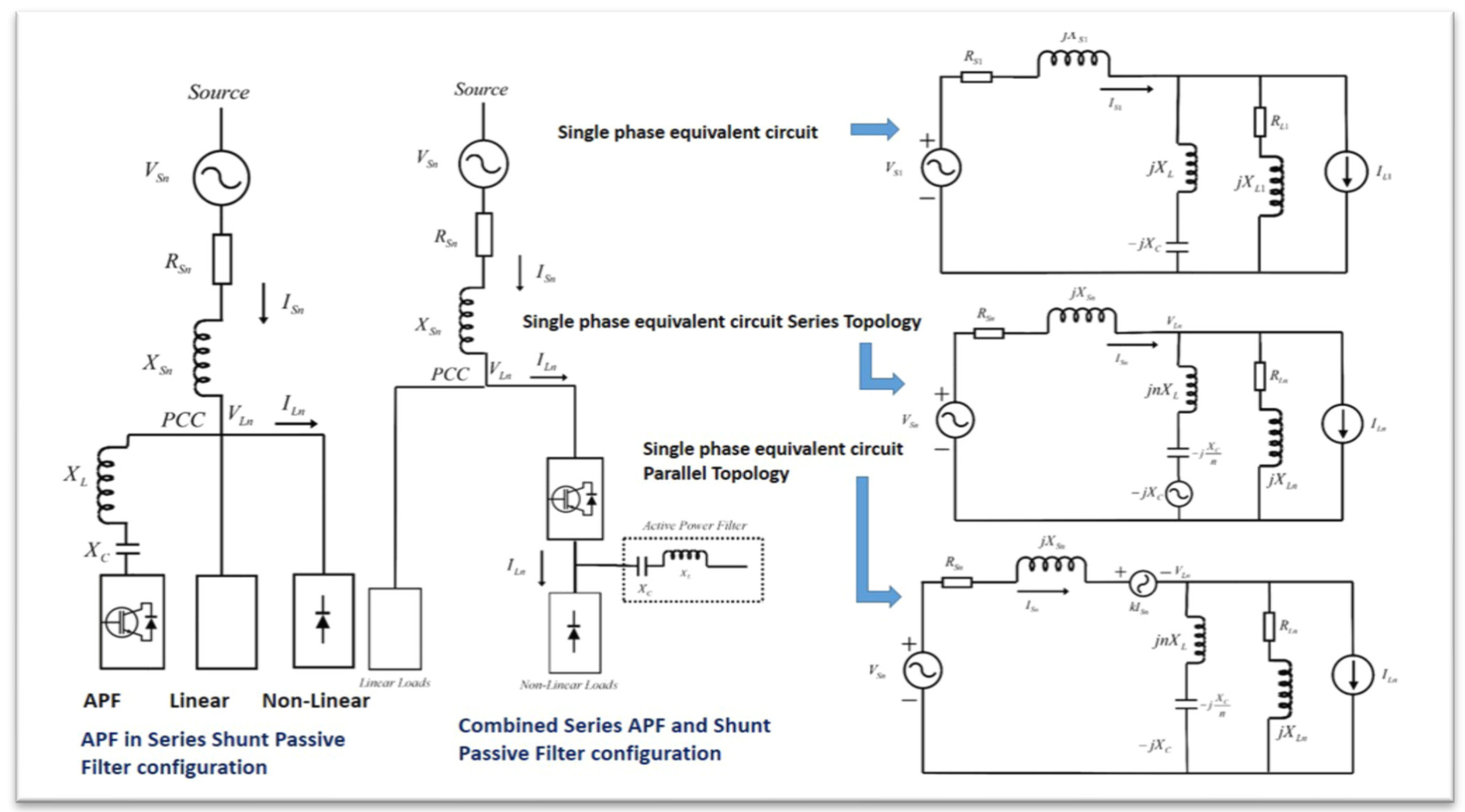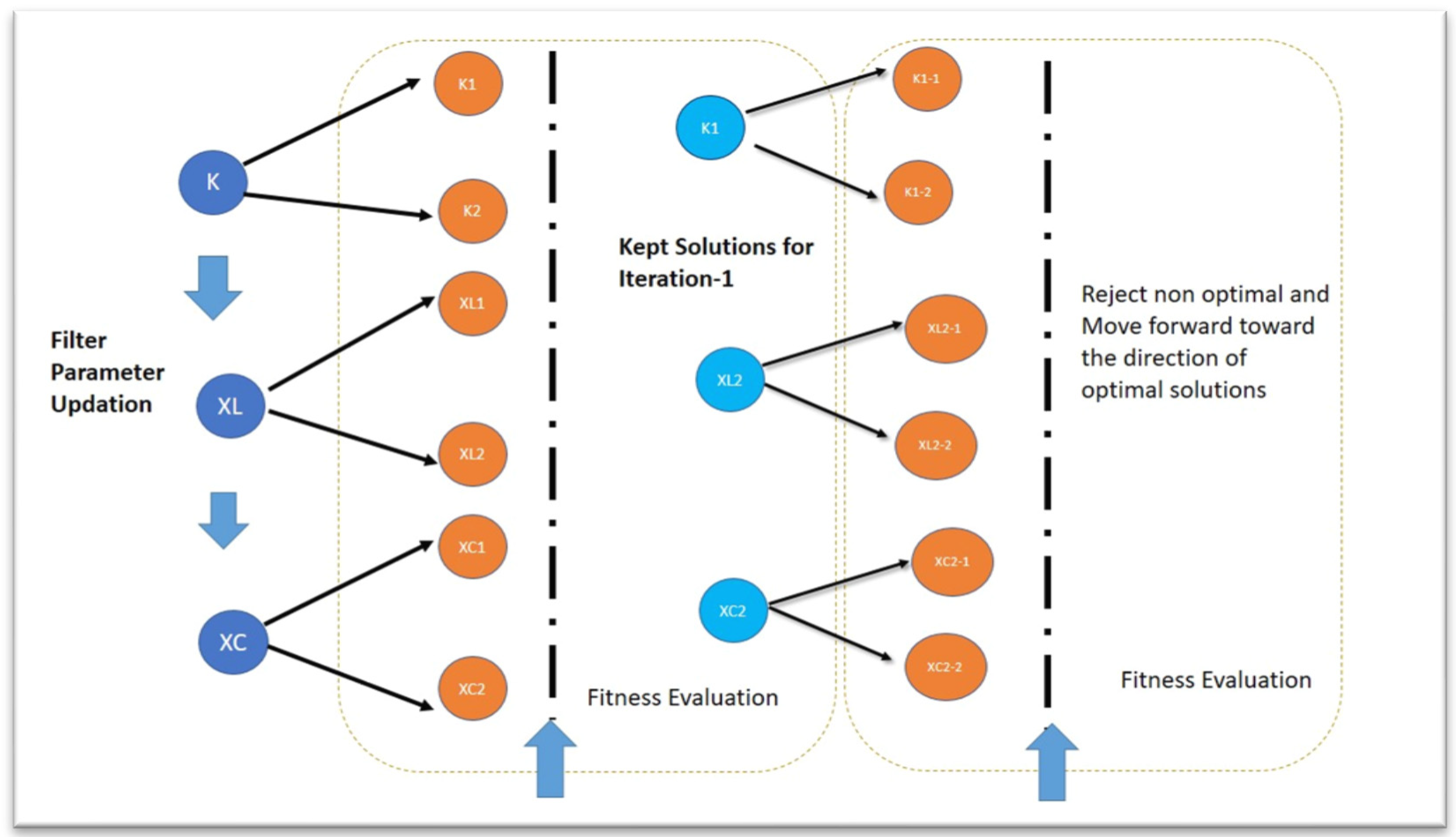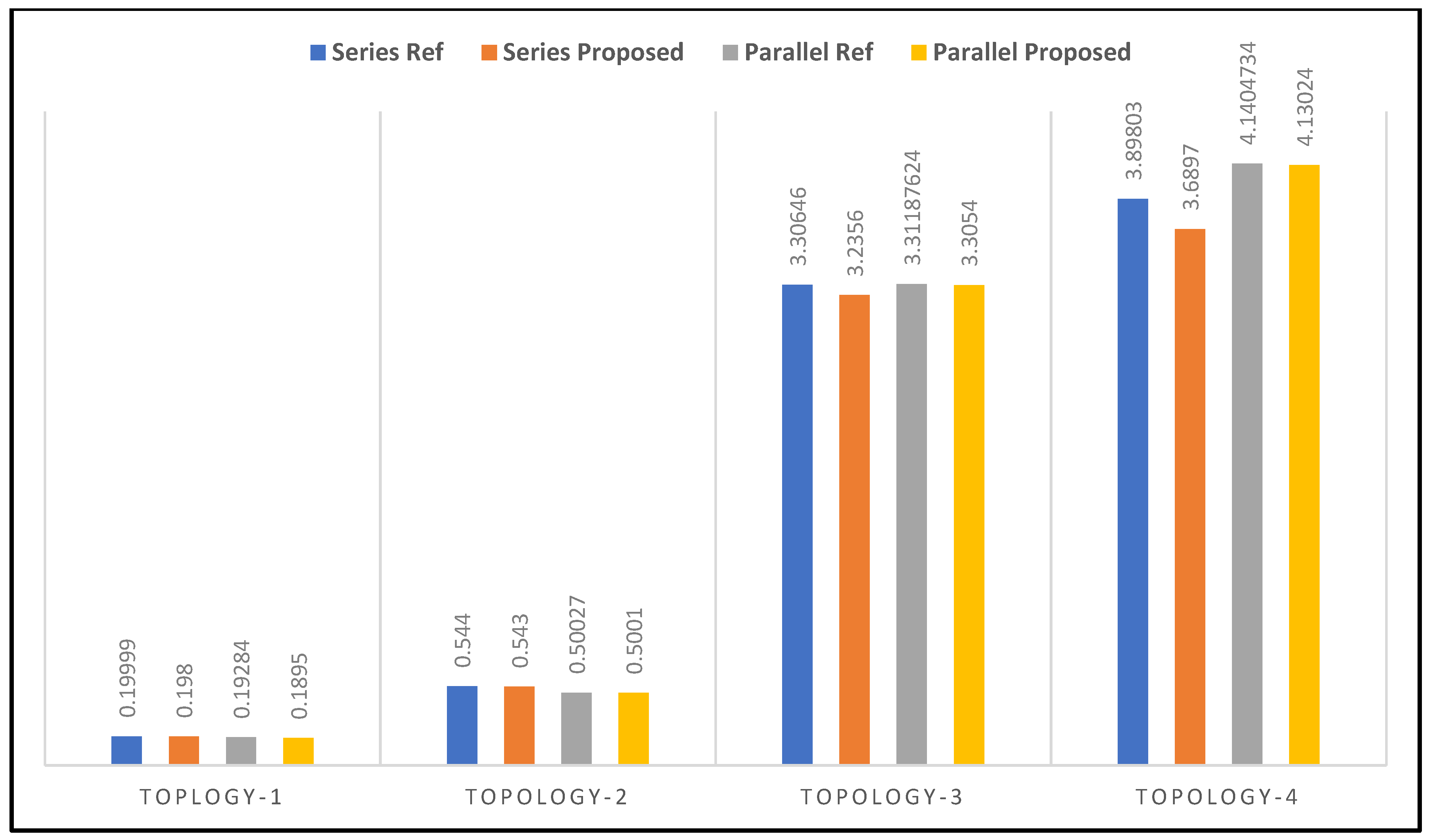An Amended Crow Search Algorithm for Hybrid Active Power Filter Design
Abstract
:1. Introduction
- Since harmonic contamination is dependent on frequency, devising mitigation technologies for handling these issues becomes an important task for the designer and system operator, as eddy current losses, skin effect, and corona losses are direct functions of the frequency;
- The presence of harmonics in the system reduces the operational efficiency of protecting devices, loads, and compensating capacitors. It badly affects the controlling devices that work on zero-crossing detection mechanisms;
- In deregulated power scenario, the price of electricity is closely associated with the power quality. Often, power producers showcase this virtue of the delivered power to the customers. Hence, clean power can have a potential contribution to the earnings of the power-generating company.
Application of Optimization Algorithms for Designing Filters
- To develop an optimization framework for parameter estimation of the configuration of two well-known hybrid filter configurations;
- To develop an objective function that explicitly inculcates harmonic pollution in account for solving parameter estimation problem of Hybrid Active Power Filter;
- To develop a framework based on the local search strategy derived from pattern search algorithm for the development of ACSA;
- To evaluate the applicability of ACSA-HAPF designs based on different test cases and evaluation methods.
2. Problem Formulation
Fitness Function for Filter Design
3. Amended Crow Search Algorithm (ACSA)
Pattern Search for Amended Search
- Evaluation of the position of the crow in stage 2, stack the position values for Filter Gain and other parameters of HAPF, and also save the fitness values of the corresponding positions;
- Parameters are appended in two diverse directions by using the gradient rule. For calculating gradients, fitness evaluation of the successive runs, along with the change in parameter values, are observed;
- After updating the parameters by gradient rule, the fitness function is evaluated; if the optimal solution arrives, we keep the solution; otherwise, we reject the solution and keep the previous one. This process is iterated in the inner loop of the phase five times (Algorithm 1).
| Algorithm 1. The iterative Process of Amended Crow Search Algorithm |
|
4. Results Analysis
- a.
- The optimization routine has been repeated 30 times, and values of the harmonic pollution parameter have been calculated for every algorithm. These values are stacked in one array, and the mean, maximum, minimum, and standard deviation of these values are obtained;
- b.
- Further, from these values (depicted in Table 1), the efficacy of the proposed algorithm in obtaining accurate parameters of the filter can be judged. It is found that the algorithm finds a suitable bridging between the exploration and exploitation phases with the modified bridging mechanism. The values of HP are aligned with the previously published results. Moreover, it has been observed that some of the algorithms, namely, SCA and WOA, exhibit high values of standard deviation in the parameter estimation process;
- c.
- High values of standard deviation show the inability of the algorithm to solve the estimation process accurately. With these high values, it can be concluded that the filter design problem is sensitive toward the algorithm mechanism and possess a highly nonlinear nature;
- d.
- Inspecting the values from Case-1 to Case-8, the authors observed that the variation between mean and maximum values is smaller. This observation indicates that the proposed algorithm ACSA is very effective and accurate for solving the design problem. On the other hand, SCA, WOA, and other algorithms give inaccurate results.
5. Conclusions
- The proposed HAPF design is based on the explicit involvement of filter parameters for achieving minimum values of an objective function that is an indicator of signal health. A fair comparison has been executed between some contemporary optimizers for solving this optimization problem;
- It has been observed that the proposed design exhibits satisfactory performance in the estimation of components of HAPF. This conclusion is based on the optimal values obtained by ACSA for error in the objective function and HP values;
- The efficacy of this design has been validated by various tests, significance analysis, and statistical calculations. These are, namely, statistical attribute analysis and comparison of filter performance with the help of THD analysis of the existing proposed filter of (MPASCA). All these analyses indicate that there are positive implications for proposed modifications in CSA.
Author Contributions
Funding
Data Availability Statement
Acknowledgments
Conflicts of Interest
References
- Singh, B.; Al-Haddad, K.; Chandra, A. A review of active filters for power quality improvement. IEEE Trans. Ind. Electron. 1999, 46, 960–971. [Google Scholar] [CrossRef]
- Vural, R.A.; Yildirim, T.; Kadioglu, T.; Basargan, A. Performance evaluation of evolutionary algorithms for optimal Filter design. IEEE Trans. Evol. Comput. 2011, 16, 135–147. [Google Scholar] [CrossRef]
- Cui, Z.; Li, C.; Dai, W.; Zhang, L.; Wu, Y. A hierarchical teaching-learning-based optimization algorithm for optimal design of hybrid active power filter. IEEE Access 2020, 8, 143530–143544. [Google Scholar] [CrossRef]
- Biswas, P.P.; Suganthan, P.; Amaratunga, G.A. Amaratunga, Minimizing harmonic distortion in power system with optimal design of hybrid active power filter using differential evolution. Appl. Soft Comput. 2017, 61, 486–496. [Google Scholar] [CrossRef]
- Chang, Y.-P.; Ko, C.-N. A pso method with nonlinear time-varying evolution based on neural network for design of optimal harmonic filters. Expert Syst. Appl. 2009, 36, 6809–6816. [Google Scholar] [CrossRef]
- Chang, Y.-P.; Low, C. An ant direction hybrid differential evolution heuristic for the large-scale passive harmonic filters planning problem. Expert Syst. Appl. 2008, 35, 894–904. [Google Scholar] [CrossRef]
- Mohammadi, M. Bacterial foraging optimization and adaptive version for economically optimum sitting, sizing and harmonic tuning orders setting of lc harmonic passive power filters in radial distribution systems with linear and nonlinear loads. Appl. Soft Comput. 2015, 29, 345–356. [Google Scholar] [CrossRef]
- Tiwari, A.K.; Dubey, S.P. Ant colony optimization-based hybrid active power filter for harmonic compensation. In Proceedings of the 2016 International Conference on Electrical, Electronics, and Optimization Techniques (ICEEOT), Chennai, India, 3–5 March 2016; pp. 777–782. [Google Scholar]
- Yang, N.-C.; Le, M.-D. Optimal design of passive power filters based on multi-objective bat algorithm and pareto front. Appl. Soft Comput. 2015, 35, 257–266. [Google Scholar] [CrossRef]
- Askarzadeh, A. A novel metaheuristic method for solving constrained engineering optimization problems: Crow search algorithm. Comput. Struct. 2016, 169, 1–12. [Google Scholar] [CrossRef]
- Saxena, A. An efficient harmonic estimator design based on Augmented Crow Search Algorithm in noisy environment. Expert Syst. Appl. 2022, 194, 116470. [Google Scholar] [CrossRef]
- Arora, S.; Singh, H.; Sharma, M.; Sharma, S.; Anand, P. A new hybrid algorithm based on grey wolf optimization and crow search algorithm for unconstrained function optimization and feature selection. IEEE Access 2019, 7, 26343–26361. [Google Scholar] [CrossRef]
- Akash, S.; Zeineldin, R.A.; Mohamed, A.W. Development of Grey Machine Learning Models for Forecasting of Energy Consumption, Carbon Emission and Energy Generation for the Sustainable Development of Society. Mathematics 2023, 16, 1505. [Google Scholar]
- Saxena, A.; Alshamrani, A.M.; Alrasheedi, A.F.; Alnowibet, K.A.; Mohamed, A.W. A Hybrid Approach Based on Principal Component Analysis for Power Quality Event Classification Using Support Vector Machines. Mathematics 2022, 10, 2780. [Google Scholar] [CrossRef]
- Ali, S.; Bhargava, A.; Saxena, A.; Kumar, P. A Hybrid Marine Predator Sine Cosine Algorithm for Parameter Selection of Hybrid Active Power Filter. Mathematics 2023, 11, 598. [Google Scholar] [CrossRef]
- Sharma, N.; Sharma, H.; Sharma, A.; Bansal, J.C. Grasshopper inspired artificial bee colony algorithm for numerical optimisation. J. Exp. Theor. Artif. Intell. 2021, 33, 363–381. [Google Scholar] [CrossRef]
- 519-2014-IEEE; Recommended Practices and Requirements for Harmonic Control in Electric Power Systems. IEEE: New York, NY, USA, 2014. [CrossRef]
- Mirjalili, S. SCA: A sine cosine algorithm for solving optimization problems. Knowl.-Based Syst. 2016, 96, 120–133. [Google Scholar] [CrossRef]
- Mirjalili, S.; Mirjalili, S.M.; Lewis, A. Grey wolf optimizer. Adv. Eng. Softw. 2014, 69, 46–61. [Google Scholar] [CrossRef]
- Mirjalili, S.; Lewis, A. The whale optimization algorithm. Adv. Eng. Softw. 2016, 95, 51–67. [Google Scholar] [CrossRef]
- Heidari, A.A.; Mirjalili, S.; Faris, H.; Aljarah, I.; Mafarja, M.; Chen, H. Harris hawks optimization: Algorithm and applications. Futur. Gener. Comput. Syst. 2019, 97, 849–872. [Google Scholar] [CrossRef]




| Algorithm | Case-1 | Algorithm | Case-5 | ||||||
| Maximum | Minimum | STD | Mean | Maximum | Minimum | STD | Mean | ||
| SCA [18] | 1.448856 | 0.236311 | 0.530824 | 0.664196 | SCA | 1.538961 | 0.227382 | 0.516208 | 0.539479 |
| GWO [19] | 0.493408 | 0.235755 | 0.078921 | 0.262403 | GWO | 0.459376 | 0.227343 | 0.095974 | 0.280593 |
| WOA [20] | 0.445305 | 0.235773 | 0.069155 | 0.297032 | WOA | 0.527085 | 0.227318 | 0.068884 | 0.266792 |
| CSA [10] | 0.493042 | 0.235827 | 0.101241 | 0.429355 | CSA | 0.458836 | 0.227334 | 0.097015 | 0.404364 |
| ACSA | 0.493027 | 0.235812 | 0.120879 | 0.407646 | ACSA | 0.458821 | 0.22741 | 0.051678 | 0.446843 |
| HHO [21] | 1.448856 | 0.236311 | 0.530824 | 0.664196 | HHO | 1.538961 | 0.227382 | 0.516208 | 0.539479 |
| Algorithm | Case-2 | Algorithm | Case-6 | ||||||
| Maximum | Minimum | STD | Mean | Maximum | Minimum | STD | Mean | ||
| SCA [18] | 2.781007 | 2.732259 | 0.017291 | 2.750023 | SCA | 2.994494 | 2.70499 | 0.062621 | 2.771687 |
| GWO [19] | 2.76437 | 2.741872 | 0.006483 | 2.751549 | GWO | 2.953492 | 2.740731 | 0.070926 | 2.784176 |
| WOA [20] | 8.750862 | 2.671969 | 1.339977 | 3.060029 | WOA | 2.853276 | 2.69237 | 0.038325 | 2.771023 |
| CSA [10] | 2.9529 | 2.748966 | 0.081267 | 2.907062 | CSA | 2.949347 | 2.684705 | 8.63 × 10−2 | 2.907657 |
| ACSA | 2.952703 | 2.690854 | 0.10314 | 2.887101 | ACSA | 2.949586 | 2.751122 | 8.56 × 10−2 | 2.900906 |
| HHO [21] | 2.781007 | 2.732259 | 0.017291 | 2.750023 | HHO | 2.994494 | 2.70499 | 0.062621 | 2.771687 |
| Algorithm | Case-3 | Algorithm | Case-7 | ||||||
| Maximum | Minimum | STD | Mean | Maximum | Minimum | STD | Mean | ||
| SCA [18] | 5.928603 | 5.677806 | 0.080314 | 5.743679 | SCA | 5.916098 | 5.666813 | 0.093673 | 5.749411 |
| GWO [19] | 38.69551 | 3.934576 | 7.388896 | 7.357326 | GWO | 41.90414 | 5.571101 | 11.12974 | 10.8523 |
| WOA [20] | 41.00736 | 5.543984 | 12.3609 | 11.70034 | WOA | 36.96037 | 1.93019 | 9.824782 | 10.00604 |
| CSA [10] | 5.888007 | 5.887952 | 1.66 × 10−5 | 5.887969 | CSA | 5.888667 | 5.672008 | 0.060736 | 5.868386 |
| ACSA | 5.888005 | 5.887955 | 1.54 × 10−5 | 5.887974 | ACSA | 5.888006 | 5.887948 | 1.63 × 10−5 | 5.887967 |
| HHO [21] | 5.928603 | 5.677806 | 0.080314 | 5.743679 | HHO | 5.916098 | 5.666813 | 0.093673 | 5.749411 |
| Algorithm | Case-4 | Algorithm | Case-8 | ||||||
| Maximum | Minimum | STD | Mean | Maximum | Minimum | STD | Mean | ||
| SCA [18] | 6.561753 | 6.343699 | 0.06756 | 6.405037 | SCA | 496.3862 | 2.793472 | 109.2909 | 32.58135 |
| GWO [19] | 33.29548 | 2.377242 | 9.731524 | 11.46938 | GWO | 29.16094 | 6.493424 | 8.009502 | 12.17118 |
| WOA [20] | 35.80203 | 2.901182 | 8.878828 | 11.23005 | WOA | 27.04237 | 1.254234 | 5.913472 | 9.749383 |
| CSA [10] | 80.27465 | 5.967958 | 17.49414 | 17.83506 | CSA | 45.31236 | 4.056495 | 8.817461 | 10.52432 |
| ACSA | 40.76756 | 6.25924 | 10.17947 | 14.54976 | ACSA | 29.71758 | 6.492036 | 5.82 × 10+0 | 10.60139 |
| HHO [21] | 6.561753 | 6.343699 | 0.06756 | 6.405037 | HHO | 496.3862 | 2.793472 | 109.2909 | 32.58135 |
| Cases | Parameters | SCA [18] | GWO [19] | WOA [20] | CSA [10] | HHO [21] | ACSA |
|---|---|---|---|---|---|---|---|
| Case-1 | Mean | −9.10328 | −9.33796 | −9.59058 | −9.40278 | −9.25919 | −9.63677 |
| SD | 0.642582 | 0.108618 | 0.095012 | 0.136469 | 0.305745 | 0.165506 | |
| Max | −8.14792 | −9.32026 | −9.386 | −9.32077 | −8.48741 | −9.39076 | |
| Min | −9.67366 | −9.6748 | −9.67504 | −9.67503 | −9.67428 | −9.67504 | |
| Case-2 | Mean | −6.44891 | −6.78382 | −1.38319 | −6.50687 | −6.51822 | −6.54087 |
| SD | 0.261048 | 0.000688 | 23.86347 | 0.101771 | 0.213466 | 0.138216 | |
| Max | −6.20066 | −6.78255 | 100 | −6.46297 | −5.92163 | −6.46302 | |
| Min | −6.77524 | −6.78487 | −6.78502 | −6.78479 | −6.78151 | −6.78499 | |
| Case-3 | Mean | −1.89393 | 8.305361 | 23.61121 | −1.76545 | 8.464069 | −1.76544 |
| SD | 0.109313 | 31.35932 | 45.24906 | 3.73 × 10−5 | 31.30597 | 2.91 × 10−5 | |
| Max | −1.67799 | 100 | 100 | −1.76538 | 100 | −1.76538 | |
| Min | −2.05023 | −2.08313 | −2.08387 | −1.76549 | −1.99496 | −1.76548 | |
| Case-4 | Mean | −0.89175 | −0.13287 | 0.359678 | 0.85779 | 0.556368 | 0.612018 |
| SD | 0.147984 | 1.052616 | 0.917454 | 0.437766 | 0.799542 | 0.766013 | |
| Max | −0.44186 | 1 | 1 | 1 | 1 | 1 | |
| Min | −1.07148 | −1.10087 | −1.0892 | −0.4428 | −1.00297 | −1.10185 | |
| Case-5 | Mean | −9.23289 | −9.60963 | −9.63201 | −9.44075 | −9.2848 | −9.3846 |
| SD | 0.620599 | 0.135475 | 0.095022 | 0.130066 | 0.261343 | 0.071097 | |
| Max | −8.03216 | −9.3664 | −9.27301 | −9.36797 | −8.66788 | −9.36797 | |
| Min | −9.66455 | −9.68655 | −9.68668 | −9.68667 | −9.66196 | −9.68636 | |
| Case-6 | Mean | −6.59211 | −6.74522 | −6.67754 | −6.53541 | −6.52537 | −6.55596 |
| SD | 0.235935 | 0.109231 | 0.189649 | 0.096793 | 0.203477 | 0.121008 | |
| Max | −6.14447 | −6.49176 | −6.16353 | −6.49218 | −5.91236 | −6.49218 | |
| Min | −6.7822 | −6.79107 | −6.79132 | −6.79124 | −6.79132 | −6.79132 | |
| Case-7 | Mean | −1.91137 | 33.78636 | 23.60986 | −1.79384 | 23.78867 | −1.76546 |
| SD | 0.129985 | 49.84994 | 45.25007 | 0.088304 | 45.14408 | 3.38 × 10−5 | |
| Max | −1.6719 | 100 | 100 | −1.76441 | 100 | −1.76535 | |
| Min | −2.04358 | −2.07982 | −2.08432 | −2.08486 | −2.06681 | −1.7655 | |
| Case-8 | Mean | 0.052851 | 0.276124 | 0.673487 | 0.788545 | 0.915925 | 0.422099 |
| SD | 0.845179 | 0.910051 | 0.683218 | 0.574427 | 0.375996 | 0.835854 | |
| Max | 1 | 1 | 1 | 1 | 1 | 1 | |
| Min | −0.81515 | −0.85589 | −0.85286 | −0.85916 | −0.6815 | −0.85911 |
| Series | ITHD (%) | VTHD (%) | Parallel | ITHD (%) | VTHD (%) | ||||
|---|---|---|---|---|---|---|---|---|---|
| Ref [15] | Proposed | Ref [15] | Proposed | Ref [15] | Proposed | Ref [15] | Proposed | ||
| Toplogy-1 | 0.12497 | 0.1248 | 0.19999 | 0.198 | Toplogy-1 | 0.12044 | 0.12 | 0.19284 | 0.1895 |
| Topology-2 | 2.67705 | 2.651 | 0.544 | 0.543 | Topology-2 | 2.7084 | 2.707 | 0.50027 | 0.5001 |
| Topology-3 | 4.6085 | 4.595 | 3.30646 | 3.2356 | Topology-3 | 4.6155 | 4.593 | 3.3118762 | 3.3054 |
| Topology-4 | 4.9987 | 4.8896 | 3.89803 | 3.6897 | Topology-4 | 4.9869 | 4.963 | 4.1404734 | 4.13024 |
Disclaimer/Publisher’s Note: The statements, opinions and data contained in all publications are solely those of the individual author(s) and contributor(s) and not of MDPI and/or the editor(s). MDPI and/or the editor(s) disclaim responsibility for any injury to people or property resulting from any ideas, methods, instructions or products referred to in the content. |
© 2023 by the authors. Licensee MDPI, Basel, Switzerland. This article is an open access article distributed under the terms and conditions of the Creative Commons Attribution (CC BY) license (https://creativecommons.org/licenses/by/4.0/).
Share and Cite
Ali, S.; Bhargava, A.; Saxena, A.; Almazyad, A.S.; Sallam, K.M.; Mohamed, A.W. An Amended Crow Search Algorithm for Hybrid Active Power Filter Design. Processes 2023, 11, 2550. https://doi.org/10.3390/pr11092550
Ali S, Bhargava A, Saxena A, Almazyad AS, Sallam KM, Mohamed AW. An Amended Crow Search Algorithm for Hybrid Active Power Filter Design. Processes. 2023; 11(9):2550. https://doi.org/10.3390/pr11092550
Chicago/Turabian StyleAli, Shoyab, Annapurna Bhargava, Akash Saxena, Abdulaziz S. Almazyad, Karam M. Sallam, and Ali Wagdy Mohamed. 2023. "An Amended Crow Search Algorithm for Hybrid Active Power Filter Design" Processes 11, no. 9: 2550. https://doi.org/10.3390/pr11092550






